
How to Graft Peyote Cactus
While peyote is fairly easy to grow, it takes many years to reach maturity. Grafting can significantly speed up growth—tripling or even quadrupling the rate of maturation! Keep reading to find out more.
Growing peyote is easy, but it takes patience. One way to overcome this is by grafting the slow-growing peyote onto faster-growing cacti. Performed successfully, this method will significantly boost the growth rate of the peyote cactus. But how exactly does grafting work, and is it really possible to Frankenstein one cactus to another? Let’s take a closer look.
What exactly is grafting?
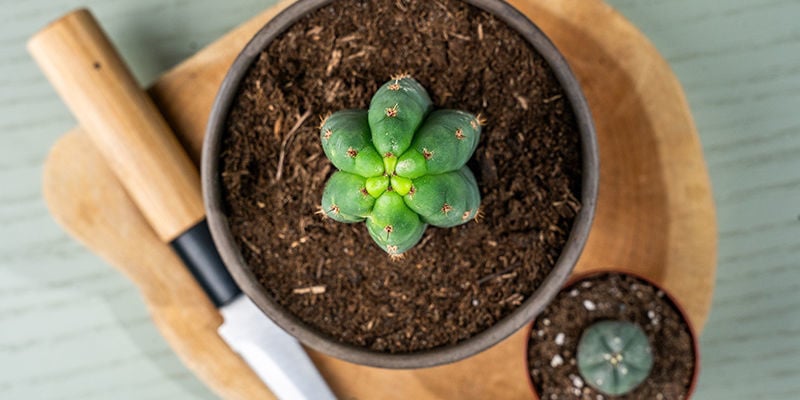
Grafting combines one cactus species with another, harnessing the transfer of moisture, energy, and nutrients to give slow-growing varieties a much-needed boost. While it may sound like a Frankenstein experiment gone awry, it’s a perfectly viable and exciting process for growers to play around with.
Before undertaking surgical procedures on your cacti, it is important to note that increasing the growth rate through grafting does not necessarily lead to increased alkaloid production. While the grafted peyote continues to produce alkaloids, there is limited evidence that the rate of production increases compared to rooted specimens. Water stress and maturity are known to influence alkaloid production significantly, but the jury is still out on grafting.
Grafting terminology
At its core, grafting is a simple technique, but if you want to master it and start grafting large cactus varieties, it’s important you understand the key terminology and concepts. With that in mind, below are the main principles.
- Rootstock and scion: The rootstock is the base plant (the older variety) and supplies the grafted variety with the nutrients it needs to thrive. The scion is the upper plant that attaches to the rootstock.
- Vascular ring: Cut open a cactus, and you’ll notice a ring at the centre. This supplies the nutrients and moisture needed for the cactus to grow.
- Union: As the name implies, a union is the successful grafting of one cactus to another. The older rootstock successfully supplies the scion with everything it needs to grow.
- Flat/lateral graft: This is the most common and easiest graft to master. You simply cut both cacti so the rootstock and scion are similar in width. At the same time, you’ll want to make sure that the vascular rings align.
What are the benefits of grafting?
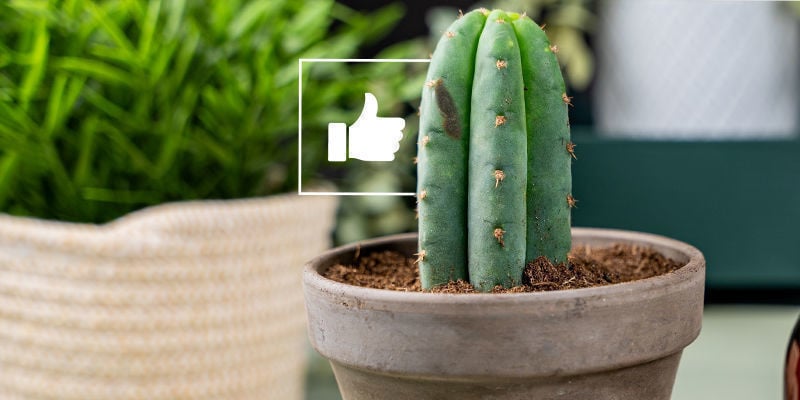
The primary benefit of grafting is the boost in growth that fast-rooting varieties can give to more decorative species. The latter is usually less versatile and more challenging to grow, so combining it with a robust rootstock is the perfect way to supercharge growth. However, it’s not the only reason to try your hand at grafting.
- Grafting can save a sick or dying cactus, as you can graft the remaining parts onto a healthy scion.
- You can use grafting to clone slow-growing varieties easily.
- Some highly specialised varieties won’t survive without the boost to flowering and fruiting provided by a vigorous rootstock.
What’s the best graft for peyote?
Peyote is naturally a slow-developing cactus variety, taking many years to reach maturity. So, if you want your graft to succeed, pair it with a suitable rootstock. In this case, Echinopsis pachanoi (San Pedro) or Echinopsis peruviana (Peruvian torch) are excellent choices.
By comparison, a San Pedro cactus can reach maturity in as little as five years, while some peyote won’t be ready to flower for 10–30 years. If you plan to harvest your peyote for recreational purposes, waiting for it to mature simply isn’t feasible in the short term, hence the use of grafting.
How to graft a peyote cactus: step by step
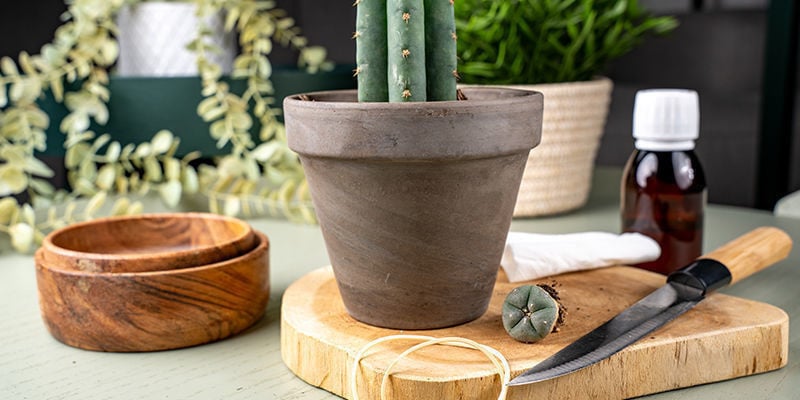
The following is a guide on how to graft a peyote cactus onto a Peruvian torch cactus, also known as Echinopsis peruviana (formerly Trichocereus peruvianus). However, the same technique will also work for San Pedro and other cacti.
Equipment
- Echinopsis cactus (the older, the better)
- Peyote
- Methylated spirits
- Clean razor blade or sharp knife
- Rubber bands
Directions
- Dip your blade into the methylated spirits to sterilise it (this must be done before every cut).
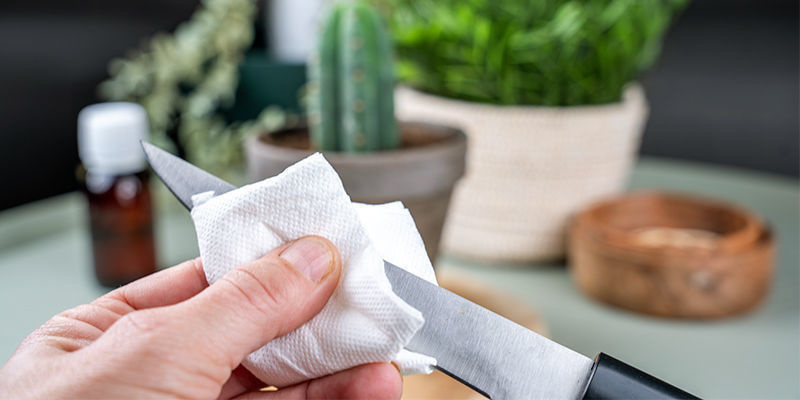
- In one clean cut, remove a few centimetres from the top of the Echinopsis.
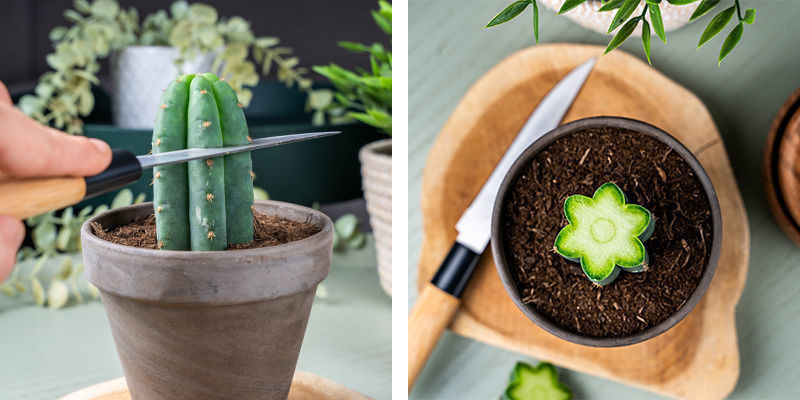
- Bevel the top of each rib on the Echinopsis. This will stop the graft from being pulled apart as the cut dries.
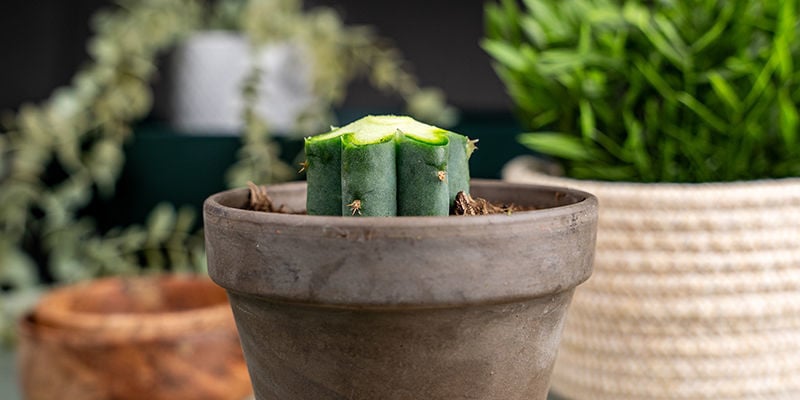
- Now, the top of the rootstock plant must be cut off again, but this time, only a very thin slice must be removed. It should be left in place so that the top does not begin to dry out. This thin slice will be removed just before the graft is made.
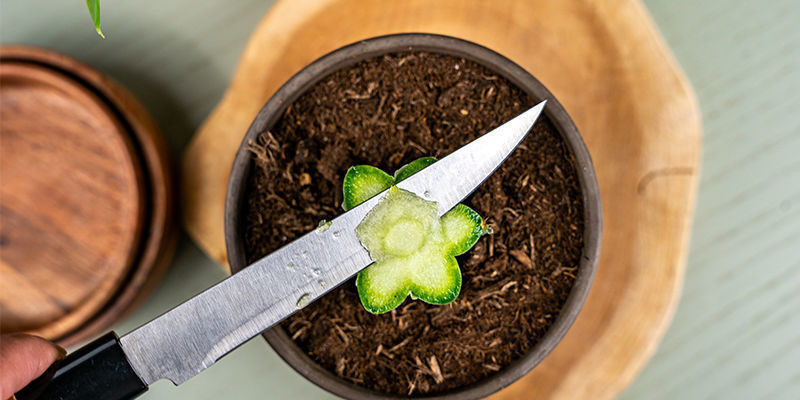
- Repeat the above process with the peyote, but cut off the bottom part, making the initial cut slightly above the roots.
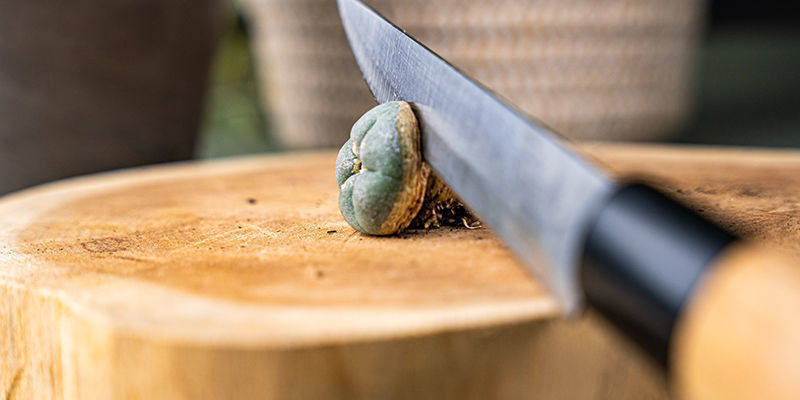
- Before the graft, locate the vascular ring on both the rootstock cactus and the peyote. It looks like a circle within the central area of the cut. This ring is how food is transported in both plants, and when it comes to the graft, they must overlap.

NOTE: It is not vital to line them up perfectly; they only need to be in contact and partially overlap. - Now, you can remove the thin protective sliver you cut from both the rootstock of Echinopsis and the peyote.
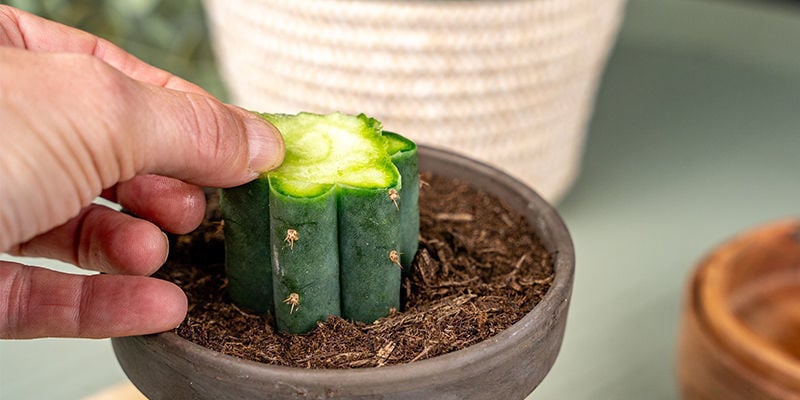
- Gently press the peyote onto the top of the Echinopsis to remove any air. During this process, it is important to remember where the vascular rings are.
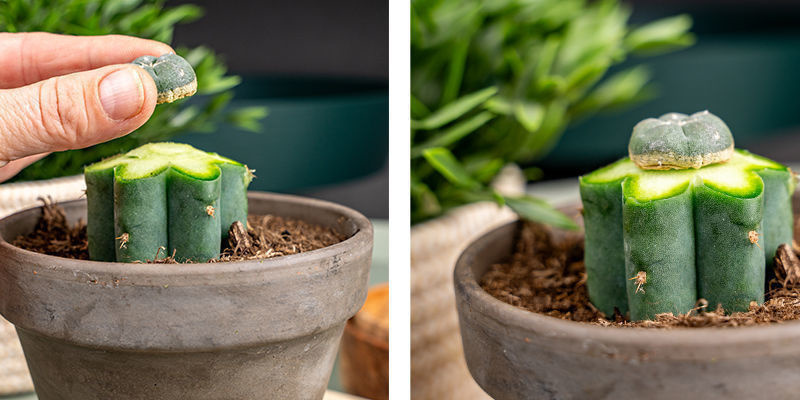
- Line up the vascular rings. If you fail to do this, the peyote will die as it cannot feed from the Echinopsis.
- Wrap rubber bands vertically around the pot of the Echinopsis and over the peyote to maintain pressure. This may take a bit of practice. Alternatively, a piece of leather with attached weights can be placed on top to press down the peyote.
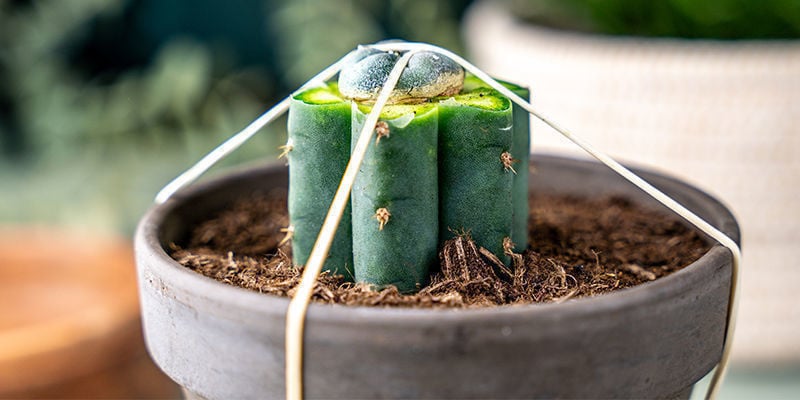
- Place the grafting in a warm, dry place out of direct sunlight.
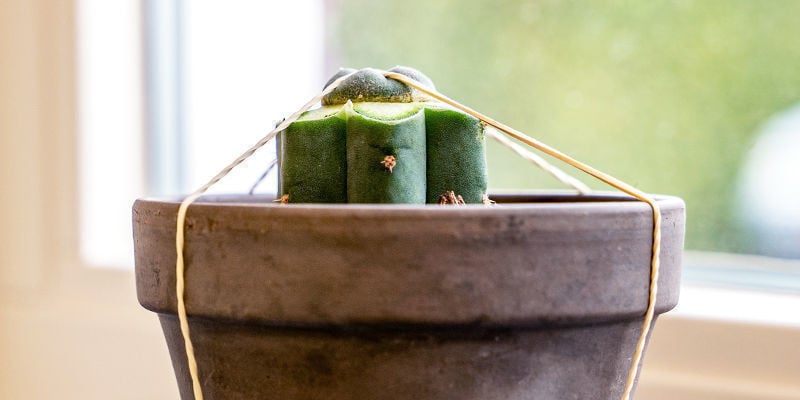
- Leave it for a week. After this period, you can now remove the rubber bands or weights, as the peyote should have successfully grafted onto the Echinopsis.
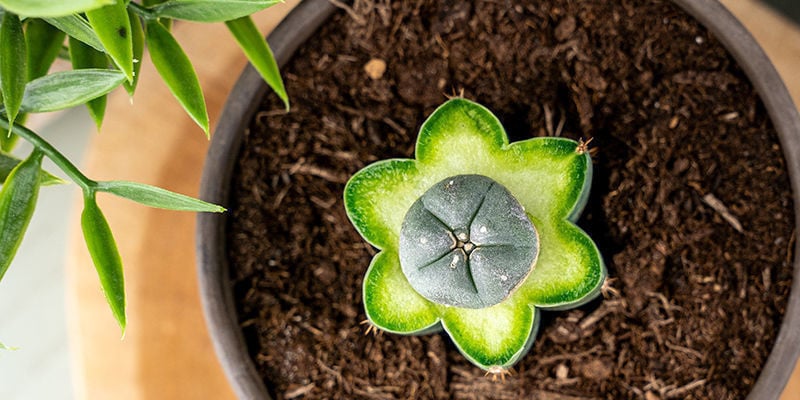
Peyote grafting hints and tips
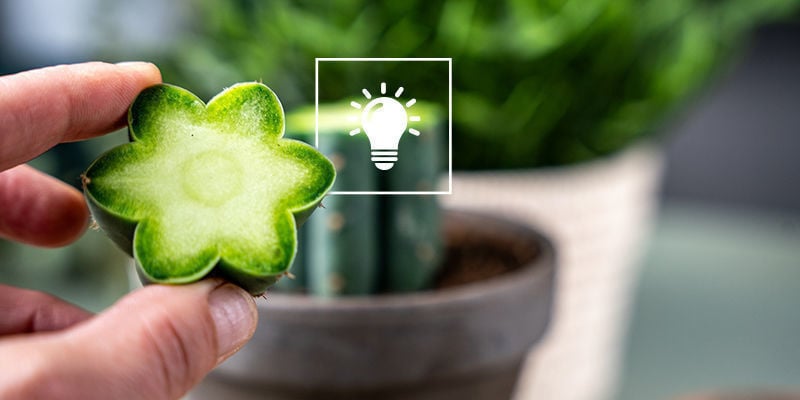
While the grafting process is fairly straightforward, here are some extra tips for growers experimenting with different cuts or unusual cactus varieties.
- Recycle leftovers: After grafting, you’ll have the top section of your rootstock and the bottom part of your scion. However, both can be replanted. The former should be left to dry for two weeks before repotting, while the latter is ready for a new home straight away.
- Experiment with different grafts: Lateral or flat grafts are the most common, but they are not the only option. Each cactus has a unique shape and structure, so try your hand at side, cleft, and slab grafts until you find the right match.
- Don’t forget aftercare: Once you’ve secured your graft, only time will tell if the transplant was successful. However, if you want to increase your chances of success, make sure your grafted plants are out of direct sunlight, watered sparingly, kept warm, and fertilised once or twice during the summer months.
- Scissors are a bad idea: While it might be tempting to cut your cactus using scissors, avoid it at all costs! When scissors pinch together, they crush the cambium, an essential layer of cells that promotes growth.
Grafting: The secret to rapid peyote growth
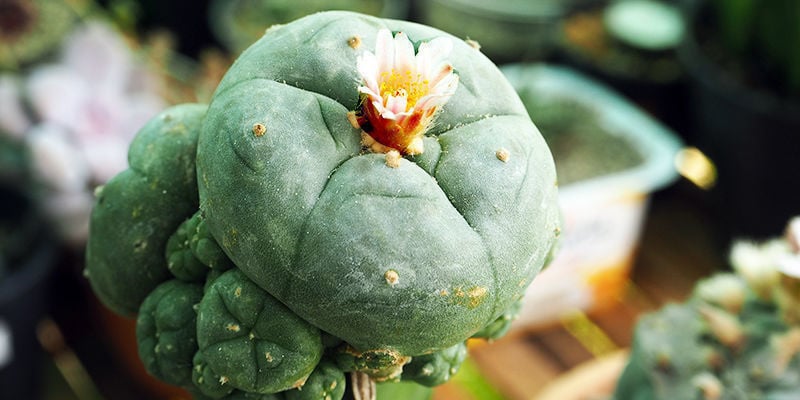
There you have it! You have now successfully grafted your peyote onto a faster-growing cactus. You should be able to literally watch the peyote balloon up, depending on the rootstock cactus. However, now the real fun begins! Armed with the grafting technique, there’s no end to the different types of cacti you can experiment with.
-
 6 min
July 11, 2024
The Ultimate Mescaline Cactus Guide
Mescaline is a time-honoured but often misunderstood drug. Here we aim to demystify it somewhat, and give a general overview of everything you need to know about mescaline cacti!
6 min
July 11, 2024
The Ultimate Mescaline Cactus Guide
Mescaline is a time-honoured but often misunderstood drug. Here we aim to demystify it somewhat, and give a general overview of everything you need to know about mescaline cacti!
-
 5 min
November 27, 2019
How To Grow Your Own Mescaline Cactus From Seed
Mescaline is a natural psychedelic produced by several types of cactus including peyote, San Pedro, and the Peruvian torch. These cacti are easy enough to grow, even if you don't have a lot of...
5 min
November 27, 2019
How To Grow Your Own Mescaline Cactus From Seed
Mescaline is a natural psychedelic produced by several types of cactus including peyote, San Pedro, and the Peruvian torch. These cacti are easy enough to grow, even if you don't have a lot of...
-
 4 min
February 3, 2019
Most Common Cactus Care Mistakes And How To Fix Them
A vast world of spiritual enlightenment awaits. At least for those who have taken the time to successfully grow a San Pedro or Peruvian torch cactus, members of the Cactaceae family. Both cacti...
4 min
February 3, 2019
Most Common Cactus Care Mistakes And How To Fix Them
A vast world of spiritual enlightenment awaits. At least for those who have taken the time to successfully grow a San Pedro or Peruvian torch cactus, members of the Cactaceae family. Both cacti...
-
 3 min
October 6, 2018
Top 5 Mescaline Cacti
Mescaline occupies the esteemed podium of naturally occurring hallucinogens along with DMT and psilocybin. The alkaloid can be found in a variety of cactus species. Here are the top 5...
3 min
October 6, 2018
Top 5 Mescaline Cacti
Mescaline occupies the esteemed podium of naturally occurring hallucinogens along with DMT and psilocybin. The alkaloid can be found in a variety of cactus species. Here are the top 5...











 United States
United States








